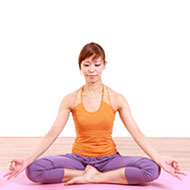Kapalbhati Pranayama
Kapalbhati Pranayama is a type of breathing exercise that helps you rid of various ailments over a period of time. "Kapal" means forehead and "bhati" means shining. Eventually, Kapabhati should bring about a glow on the face of the practitioner. Kapalabhati is done in a sitting posture.
Focus on "exhaling". Inhale as normal. Exhale and simultaneously contract the abdomen muscles with each exhalation.
All yoga practitioners give a lot of credence to this deep breathing and meditation technique. Ideal for intermediate practitioners, the Kapalbhati pranayama exercise remains a standard practice in yoga schools all over the world.
Kapalbhati pranayama is the only physical and breathing technique useful for mind detoxification and purification. In all of the cleansing routines of yoga, kapalbhati is the only one which can cleanse both the mind and the body using only breath. As a de-stressing tool, kapalbhati breathing has shown remarkable results. Some of the more prominent yoga gurus have worked hard to popularize this technique all over the world. It is this reason that the technique is often also known as baba Ramdev kapalbhati.
Kapalbhati Pranayama Benefits :
Some people perform this technique simply for its relaxing benefits, while others perform it for the physical benefits it offers. Some people perform kapalbhati for weight loss as well because it works up the respiratory system and the abdominal muscles, helping you tone out your musculature and improve body tone.
Kapalbhati clears the respiratory passages, minimizing risks of infections and allergies in the respiratory system. With the forceful breaths of kapalbhati, the allergens and the infectious materials in the lungs and the respiratory passages are blown away and removed from the body.
The exercise technique also helps improve the flexibility of the diaphragm. With the breathing technique used for this yogic kriya, the diaphragm gets plenty of exercise, becomes more pliable and improves circulation. As the diaphragm becomes stronger and more flexible, the risk of developing hernias also reduces drastically.
Since kapalbhati also helps improve blood circulation, especially to the lower half of the body, it helps improve the functioning of the entire body. Of course, the technique also helps increase the lung capacity and improves respiratory efficiency, making more oxygen available to the body. As more oxygen flows into the body, it becomes more efficient. You can feel yourself infused with energy every time you perform this technique. In addition to that, you may also feel increased mental acuity, improved concentration and heightened senses.
Kapalbhati Side Effects :
While kapalbhati is a great way to improve both your body and mind, and effectively beat stress, it is not recommended for everyone. Experts believe that certain diseases and disorders may become complicated if kapalbhati is performed regularly and unsupervised. For instance, kapalbhati is not recommended for those who suffer from cardiac problems, hernia and spinal disorders. In addition, those suffering from severe respiratory infections, colds and nasal obstruction should also not perform this breathing and cleansing technique.
Doctors usually ask people suffering from high blood pressure and diabetes to abstain from performing kapalbhati. Those with abdominal ulcers should also avoid performing the technique. Since there are some kapalbhati dangers, it is best to perform it only after consultation with your doctor and a qualified yoga instructor. It is best to avoid performing it on your own.
How To Do Kapalbhati?
Kapalbhati pranayama steps are usually very straightforward. However, it is important to ensure that you perform it properly or you may end up hurting yourself. You will also need to exercise some precautions when you perform it. You can find detailed step by step instructions on the technique here:
- Sit straight with your spine erect and cross your legs in front of you.
- Take in a deep breath and exhale quickly and suddenly, making a puffing sound while you do it. Focus on exhaling forcefully and not on the inhalation.
- When you exhale, draw your abdominal muscles inward simultaneously. Your abdomen should rise when you inhale and fold when you exhale.
- Continue for 10 breaths and then take a break. Perform two more similar sets.



